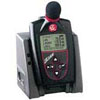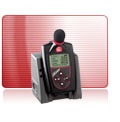No single method or process exists for measuring occupational noise. Hearing safety and health professionals can use a variety of instruments to measure noise and can choose from a variety of instruments and software to analyze their measurements. The choice of a particular instrument and approach for measuring and analyzing occupational noise depends on many factors, not the least of which will be the purpose for the measurement and the environment in which the measurement will be made. In general, measurement methods should conform to the American National Standard Measurement of Occupational Noise Exposure, ANSI S12.19-1997 [ANSI 1996a].
Measuring noise with a sound level meter is relatively simple when the noise levels are continuous and when the worker remains essentially stationary during the work shift. A noise dosimeter is preferred for measuring a worker's noise exposure when the noise levels are varying or intermittent, when they contain impulsive components, or when the worker moves around frequently during the work shift.
The noise dosimeter may be thought of as a sound level meter with an additional storage and computational function. It measures and stores the sound levels during an exposure period and computes the readout as the percent dose or TWA. Many dosimeters available today can provide an output in dose or TWA using various exchange rates (e.g., 3, 4, and 5 dB), 8-hr criterion levels (e.g., 80, 84, 85, and 90 dBA), and sound measurement ranges (e.g., 80 to 130dBA). The choice of FAST or SLOW meter response on the dosimeter does not affect the computed noise dose or TWA when the 3-dB exchange rate is used, but it will when other exchange rates are used [Earshen 1986].
In noise dosimetry, the microphone is attached on the worker whose exposure is being measured. The placement of the microphone is important in estimating the worker's exposure, as Kuhn and Guernsey [1983] have found large differences in the sound distribution about the body. ANSI [1996a] specifies that the microphone be located on the midtop of the worker's more exposed shoulder and that it be oriented approximately parallel to the plane of this shoulder.
Dosimeter: Quest EDGE Cable-Free Noise Dosimeters - EG4, EG5SKU: Quest Edge4-button Edge is easy to run and navigate. The EG4 has dual dosimeters & datalogging. The EG5 adds intrinsically safe operation & simultaneous C- and A-weighting. Technical Specifications Call for Price each Add to Cart |

|
Dosimeter: The Edge eg5 (Type 2) Noise DosimeterSKU: eg5The Edge eg5 (Type 2) Noise Dosimeter Includes EDGE 5 dosimeter with 57-309 1/4" microphone, (2) 53-613 windscreens (one with dosimeter and one extra), 53-753 Calibrator Adapter, and 53-754 Storage Case. Also available with EdgeDock-1 Single Docking Technical Specifications Call for Price each Add to Cart |

|
Some things we can help you with